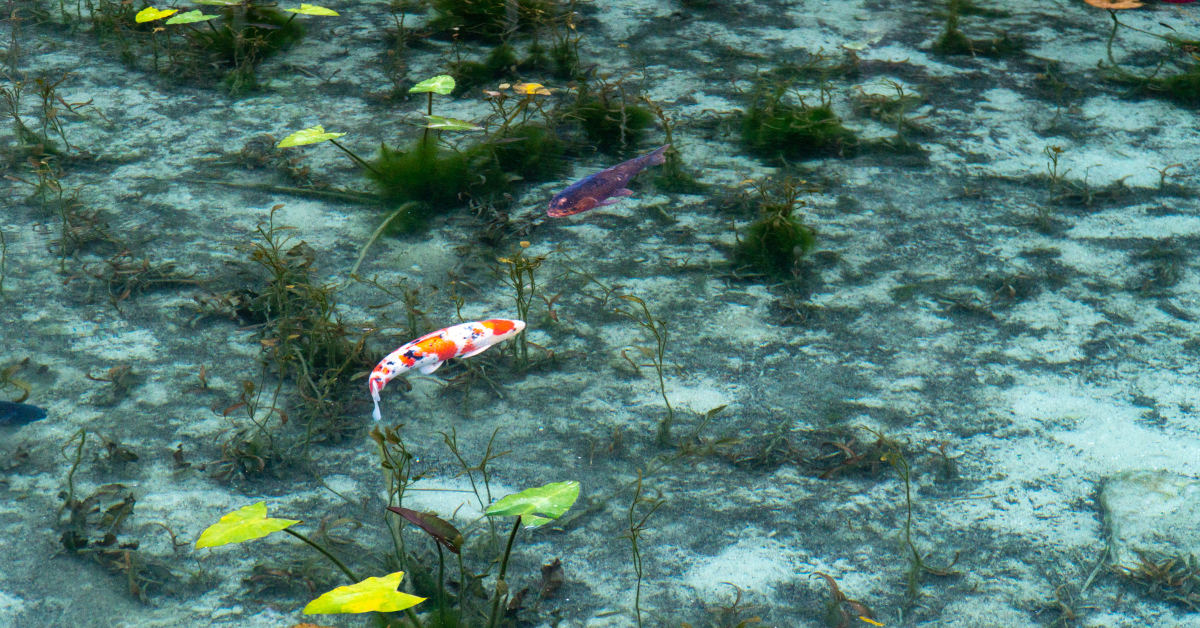When Japanese visitors come to Monet’s Pond in Gifu, many describe it as “just like a painting.” The crystal-clear water, blooming lilies, and colorful koi create a scene that is not only beautiful but also offers a unique sense of peace and reflection.
Basic Information About Monet’s Pond
Monet’s Pond is a small pond located in Itadori, Seki City, Gifu Prefecture. It became widely known in recent years, when photos shared on social media made it go viral. The pond is filled with spring water, creating astonishing clarity. Depending on the light, the water appears emerald green or cobalt blue, producing a dreamlike atmosphere.
| Item | Details |
|---|---|
| Name | Nameless Pond (commonly known as Monet’s Pond) |
| Location | Itadori, Seki City, Gifu Prefecture |
| Features | Crystal-clear water, water lilies, koi |
| Best Season | June–July (when lilies bloom) |
Nearby you can also find Itadori River hot springs and local farms, making the area popular for day trips and scenic drives.
Why Japanese People Find Monet’s Pond Attractive
Beauty Like a Painting
The first impression many Japanese visitors have is “It’s just like looking at a real painting.” Those familiar with Monet’s Water Lilies are deeply moved by the similarity, while others simply appreciate the natural harmony of colors.
Visitor Impressions
- “The reflection of the sky makes the water surface part of the artwork.”
- “The real-life view is more powerful than photos.”
- “If you know Monet’s Water Lilies, it feels extra special.”
| Japanese Impressions | Description |
|---|---|
| Like a Painting | Lilies and koi resemble an impressionist canvas |
| Beyond Photos | The colors and reflections surpass photography |
| Artistic Connection | A unique experience for those who know Monet |
Serenity and Healing
Although it is a tourist spot, Monet’s Pond is not overly commercialized. There are no flashy facilities or artificial attractions, which means visitors can enjoy nature as it is.
- Standing in front of the pond helps people forget the noise of the city
- The clarity of the water brings a sense of calm
- The quietness of each season makes the experience meditative
Older Japanese visitors often remark that it “reminds them of the rural landscapes of their youth.”
Seasonal Changes
Monet’s Pond cannot be appreciated fully in just one visit. This is because the scenery changes dramatically with each season.
| Season | Appearance of the Pond | Japanese Impressions |
|---|---|---|
| Spring | Fresh greenery reflects on the surface | “I feel the energy of new life.” |
| Summer | Lilies and koi are at their most vivid | “The colors are vibrant and photogenic.” |
| Autumn | Red and orange leaves mirror in the water | “The reflection of autumn foliage is breathtaking.” |
| Winter | Snow covers the pond in silence | “It feels like another world.” |
This is why many Japanese return again and again, embracing their culture of appreciating the differences of the four seasons.
Recommended Experiences for Foreign Visitors
When foreign visitors come to Monet’s Pond, they can deepen their experience by learning how Japanese people enjoy it.
- Don’t just take photos—observe the ripples and reflections carefully
- Visit at different times of the year to see changing landscapes
- Explore nearby spots for local food and culture
The best recommendation is to visit early in the morning. The pond is quiet, fewer people are around, and the soft light makes the water even more magical.
| Experience | How Japanese People Enjoy It |
|---|---|
| Photography | Best on calm mornings or evenings |
| Nature Observation | Watch koi movements and light reflections |
| Seasonal Visits | Summer lilies, autumn foliage, snowy winters |
How Japanese People Enjoy the Surroundings
For many Japanese visitors, the trip does not end at the pond itself. The way they spend time after visiting is also important.
- Relaxing at Itadori River hot springs
- Enjoying local dishes such as grilled sweetfish (ayu)
- Visiting nearby shrines for spiritual reflection
This flow of activities makes the experience not just about the pond, but about an entire cultural journey.
Conclusion
Monet’s Pond is more than a beautiful sightseeing spot. For Japanese people, it is a place of harmony, quiet reflection, and seasonal beauty. For foreign visitors, it can also become a window into how Japanese culture cherishes nature and the changing seasons.
While the pond is well-known through photos and videos online, the real value lies in the experience of being there—hearing the silence, seeing the koi, and feeling the passage of time.






